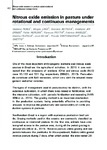Please use this identifier to cite or link to this item:
http://www.alice.cnptia.embrapa.br/alice/handle/doc/1064687Full metadata record
| DC Field | Value | Language |
|---|---|---|
| dc.contributor.author | PERES, G. R. P. | pt_BR |
| dc.contributor.author | LIMA, M. A. de | pt_BR |
| dc.contributor.author | BATISTA, G. das G. | pt_BR |
| dc.contributor.author | ANDRADE, C. A. de | pt_BR |
| dc.contributor.author | HERLING, V. R. | pt_BR |
| dc.contributor.author | PIOTTO, V. C. | pt_BR |
| dc.contributor.author | NAREZZI, F. | pt_BR |
| dc.contributor.author | FILIZOLA, H. F. | pt_BR |
| dc.contributor.author | SILVA, J. A. da | pt_BR |
| dc.contributor.author | FRIGHETTO, R. T. S. | pt_BR |
| dc.date.accessioned | 2017-02-17T11:11:11Z | pt_BR |
| dc.date.available | 2017-02-17T11:11:11Z | pt_BR |
| dc.date.created | 2017-02-17 | pt_BR |
| dc.date.issued | 2016 | pt_BR |
| dc.identifier.citation | In: INTERNATIONAL SYMPOSIUM ON GREENHOUSE GASES IN AGRICULTURE, 2., 2016, Campo Grande, MS. Proceedings... Brasília, DF: Embrapa, 2016. p. 42-47. (Embrapa Gado de Corte. Documentos, 216). | pt_BR |
| dc.identifier.uri | http://www.alice.cnptia.embrapa.br/alice/handle/doc/1064687 | pt_BR |
| dc.description | Abstract: One of the most important anthropogenic methane and nitrous oxide sources in Brazil are the agricultural activities. In 2010 it was estimated that the emissions of methane (CH4) and nitrous oxide (N2O) were 13,133 and 521 Gg, respectively (BRAZIL, 2013). Pasturelands contribute with N2O emissions, which vary with the adopted management and other variables. The types of management used in pastures may be distinct, with the extensive cultivation, in which there is no reseed or fertilization, and the intensive cultivation, with periodic fertilization and reseeding (HANSEN et al., 2014). The grazing method is an important mechanism in the production system, being potentially effective in providing answers to improve the productivity and sustainability of cattle production systems in pastures. Southeastern Brazil is a region with expressive production beef cattle. Grazing methods used in the country are commonly classified as continuous or rotational pasture. In the first one, animals have uninterrupted access to the pasture area, during all the period grazing is allowed (ALLEN et al., 2011). Rotative pasture utilize grazing and rest periods between the paddocks. In this experiment, Nelore cattle grazed rotative pasture during 7 days, after which period the area rested 28 days, totalizing a cycle of 35 days at the paddock. Mensuration of nitrogenous gas losses in tropical savanna are still scarce in literature, especially about nitrous oxide emission factors in soils with the addition of nitrogen fertilizer (SMITH, BOUWMAN, BRAATZ, 1999). This study aimed to quantify nitrous oxide emissions in pastures under two grazing methods, not fertilized and fertilized rotational, in Southeastern Brazil. | pt_BR |
| dc.language.iso | eng | eng |
| dc.rights | openAccess | eng |
| dc.subject | Emissão de gases | pt_BR |
| dc.subject | oxido nitroso | pt_BR |
| dc.title | Nitrous oxide emission in pasture under rotational and continuous managements. | pt_BR |
| dc.type | Artigo em anais e proceedings | pt_BR |
| dc.date.updated | 2017-03-06T11:11:11Z | pt_BR |
| dc.subject.thesagro | Pastagem | pt_BR |
| dc.subject.thesagro | Solo | pt_BR |
| dc.subject.thesagro | fertilizante nitrogenado | pt_BR |
| dc.subject.nalthesaurus | Greenhouse gas emissions | pt_BR |
| dc.subject.nalthesaurus | Nitrous oxide | pt_BR |
| riaa.ainfo.id | 1064687 | pt_BR |
| riaa.ainfo.lastupdate | 2017-03-06 | pt_BR |
| dc.contributor.institution | GIULIANA REGIA PINEDA PERES, CNPq; MAGDA APARECIDA DE LIMA, CNPMA; GIOVANA DAS GRACAS BAPTISTA, CNPq; CRISTIANO ALBERTO DE ANDRADE, CNPMA; VALDO HERLING, FZEA-USP; VANESSA PIOTTO, FZEA-USP; FABRICIO NAREZZI, CNPq; HELOISA FERREIRA FILIZOLA, CNPMA; JOSE ANTONIO DA SILVA, CNPq; ROSA TOYOKO SHIRAISHI FRIGHETTO, CNPMA. | pt_BR |
| Appears in Collections: | Artigo em anais de congresso (CNPMA)  | |
Files in This Item:
| File | Description | Size | Format | |
|---|---|---|---|---|
| 2016AA47.pdf | 114,42 kB | Adobe PDF |  View/Open |









